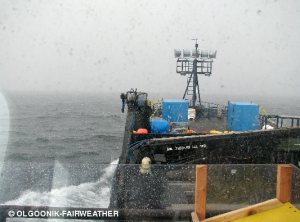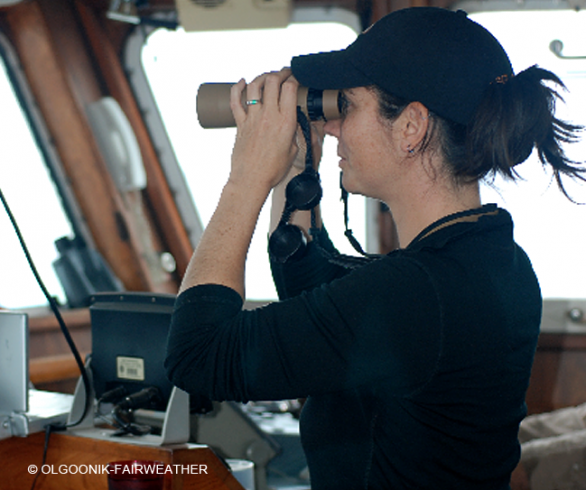Adrian Gall is a Research Biologist with the consulting firm ABR (Alaska Biological Research). Adrian is an expert in conducting boat-based marine bird and mammal surveys, and she shares her enthusiasm and knowledge about these surveys below…. 
Did you know that 70% of the planet is covered with ocean? That is over 139 million square miles of space for seabirds to travel over, eat in, and live on. They spend most of their lives out there. Surveys from ships are one way to get a look at what species hang out together and what kinds of ocean habitats they use. Many ships collect data on fish and zooplankton (bird food!) and oceanography (water temperature, salinity, and currents) at the same time that seabird surveys are taking place. As a seabird ecologist, I work with biological and physical oceanographers to test hypotheses about the ecology of the seabird community, or why we are seeing particular numbers and species of birds in particular places. If we can explain these pattern in abundance and distribution, we may also be able to predict how the patterns will change in the future. This information is especially important in areas that are vulnerable to threats from climate change, fuel spills, and other human activity.
A good seabird observer needs to have focus to scan the skies and surface of the water for up to 12 hours/day. We work from the bridge of a vessel that is steaming ahead at 5–10 knots in seas with waves up to 6 feet high. When the waves get much higher, the birds are still out there, but they become hard to see beyond the spray and the crests of the waves and it gets tricky to keep balanced well enough to look for them. In addition to being quick to spot, count, and identify birds, a seabird observer also takes note of bird behavior and distance from the ship. All of this information is recorded on a laptop computer that stamps each observation with a time and location from the ship’s Global Positioning System (GPS). At the end of a research cruise, these data are backed up on several hard drives before coming off the ship.
Back in the office, we can use the observations to make maps of seabird distributions and compare them to maps of water temperature, zooplankton distribution, fish distribution, and other data. These maps help us develop models to understand how changes in the environment can affect seabird populations. The data analysis is satisfying, but I have to admit that my favorite part of the job is standing on the bridge when a rare bird comes to visit. We have had snowy owls, peregrine falcons, and even a northern gannet (a bird only ever recorded in the Atlantic Ocean prior to our observation) zoom past the windows of the bridge. Spotting rare birds can make a seabird observer feel like s/he just found a bit of pirate treasure!
Observing conditions can be very rough!


